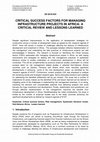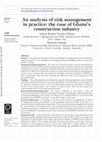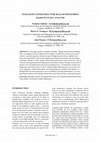Papers by Nicholas Chileshe

Despite significant improvements in the application of development strategies for construction ac... more Despite significant improvements in the application of development strategies for construction across a number of development areas as agreed by the 'research agenda of W107', there still remain a number of challenges affecting the delivery of infrastructure development and investment in Africa. The synergies between effective implementation of risk management and undertaking the best practices of infrastructure projects are well acknowledged in literature. This research is focused on identifying the critical success factors (CSFs) associated with managing infrastructure project in Africa, as well coping mechanisms and strategies for dealing with risk management practices. A systematic literature review of studies undertaken on infrastructure development in Africa will be conducted. This will be complemented by previous empirical studies undertaken on critical success factor for risk management related studies in selected Sub-Saharan African countries such as Zambia, Tanzania and Ghana which have recorded significant developments in achieving some of the nine development areas as identified by the 'research agenda of W107'. Furthermore, content analysis (CA) was employed to analyse the remaining trends and emergent research gaps. Some advocated solutions and roadmap for addressing the identified bottlenecks will be put forward. This study has a number of implications for policy makers as the identified CFSs and lesson learned can be tailored in mitigating some of the challenges in implementing risk management practices. In so doing, unlocking the dormant and unsustainable potential thus delivering projects that could harness the huge investment and development. Finally, stakeholders and practitioners can through effective implementation of risk management maximize the benefits from infrastructure development in Africa. Notwithstanding the noted contributions, the study is limited by the number of empirical studies due to the fewer countries achieving the significant developments as defined by 'research agenda of W107'.

With a focus on internal stakeholder management approaches (SMA), engagement strategies and chall... more With a focus on internal stakeholder management approaches (SMA), engagement strategies and challenges have been suggested in literature. However, there is a paucity of studies in relation to external stakeholders and in particular, South Australia. This paper aims to investigate the engagement strategies and challenges affecting the external stakeholders in adopting SMAs. 21 engagement strategies and 9 challenges were identified through a literature review, and consolidated by 5 interviews. A questionnaire instrument containing these 21 engagement strategies and 9 challenges were sent out to project management practitioners in South Australia, and 19 completed questionnaires were retrieved. The top three ranked strategies for SMAs were “stakeholder identification”, “well defined communication strategy and plan”, and “stakeholder expectations are understood”. The least ranked were “open information sharing”, and “delegating responsibility to the stakeholder”. The top three challenges were “conflicting agendas”, “scarce resources”, and “power conflicts”. In contrast, the least ranked three challenges were: “subversive stakeholders”, “passive involvement of stakeholders”, and “low turn out to meetings”. Strategies identified from the interviews included identifying stakeholders as early as the design phase of the projects. This study provides insights and raises awareness on the engagement strategies and challenges for the effective adoption of stakeholder management approaches.

Architectural Engineering and Design Management, 2016
This paper discusses a case study of Australia's most technologically advanced health facility to... more This paper discusses a case study of Australia's most technologically advanced health facility to address an identified gap in the body of the knowledge. That is, no comprehensive study has hitherto attempted to draw upon virtual team working theories to enhance collaboration in BIM-based construction networks (BbCNs). In response to this, the present study seeks to raise awareness of organisational discontinuity theory (ODT) as a recent theory for virtual teams, which enables BbCNs to embrace collaboration. To this end, the major challenges encountered and corresponding solutions adopted on a mega-project have been closely monitored and investigated. The study contributes to the field through the conceptualisation of typical barriers to collaboration in BbCNs from the perspective of ODT. Additionally, the discussions presented outline practical implications by demonstrating how the identified issues of collaboration in BbCNs could be effectively dealt with.

Journal of Engineering Design and Technology, Mar 23, 2015
Purpose -The purpose of this paper is to report the findings of research into the levels of aware... more Purpose -The purpose of this paper is to report the findings of research into the levels of awareness, usage and benefits of risk assessment and management practices (RAMP) within the construction industry in Ghana. Design/methodology/approach -The study was conducted through a structured questionnaire administered to 103 construction professionals practising with construction client (private and public), consultant and contractor organisations within the Ghanaian construction industry. The results were analysed to establish the current levels of awareness, usage and perceived benefits of risk management practices. Survey response data were subjected to descriptive statistics; subsequently, ANOVA and other non-parametric tests were used to examine the differences in the levels of agreement of the perceived benefits. Findings -This study illustrates that although the majority of the respondents are aware of RAMP, some professionals found the process not to be formal. Relative to the benefits, there was a disparity in the ranking of agreement scores on two of the eight benefits among the respondents in relation to "product to the required quality" and "reduction in contract claims". However, they all agreed on "improved team morale" as the most important benefits. Research limitations/implications -The research limitation of the study is that the cross-sectional data made it difficult to generalise the findings. Geographically, only respondents from construction organisations in the Greater Accra Region were considered. However, it is recommended that future work on RAMP be extended to cover all the regions of the country. Practical implications -The findings of the study provide practical for organisations to measure the benefits and capture the awareness of risk management practices through the provision of a framework based on an index and scoring method. This can be used by senior management in assessing the current benefit levels within projects "internal benchmarking" and has potential for external benchmarking purposes. Furthermore, through education and training, both formal and informal process including more information and provision of expertise within RAMP could enhance the levels of awareness. Originality/value -Little is known about the current levels of awareness, usage and benefits of risk management among Ghanaian construction organisations, and this study provides some insights and deepening our understanding on the uptake and perceived benefits of RAMP among construction professions in Ghana. These findings may help construction practitioners in having an increased awareness of risk management practices, and this can further lead to a higher uptake and usage resulting in reaping the advocated benefits of the implementing risk management practices such as The current issue and full text archive of this journal is available on Emerald Insight at: www.emeraldinsight.com/1726-0531.htm JEDT 13,2 240
The International Journal of Interdisciplinary Social Sciences Annual Review, 2010
This paper is part of an on-going doctoral research project based on the integration of Risk Mana... more This paper is part of an on-going doctoral research project based on the integration of Risk Management (RM) and Value Management (VM) in Public Private Partnership (PPP) project management. RM and VM are proven to be best practice methodologies to minimise risk and increase benefits in project management. There is a clear synergy between minimising risk and maximising value in a project or program and researchers and practitioners argue that integration of risk and value management will deliver better outcomes to the client than separate application of the two processes.

This paper aims to investigate and analyse the perceptions of South Australian construction pract... more This paper aims to investigate and analyse the perceptions of South Australian construction practitioners on drivers associated with adoption of reverse logistics (RL). To this end, semi-structured interviews were conducted with eight practitioners to collect data and the interview transcripts were analysed using the NVivo (version 10) software package. The study takes advantage of integration of qualitative and quantitative analysis of interview transcripts to rank the drivers on the basis of their relative importance. Results suggested that factors associated with regulations and obligations could act as the most important drivers to promote adoption of RL. The drivers associated with financial gains were identified as the second important category of drivers in RL adoption. Furthermore, environmental concerns were regarded as "slightly important" for practitioners in the South Australian construction context. The study concludes with presenting a model mapping the factors affecting the level of influence of drivers in construction projects in South Australia (SA).

The Vietnam construction industry has considerably developed since 1986 as a result of "Doi Moi" ... more The Vietnam construction industry has considerably developed since 1986 as a result of "Doi Moi" or all-round renovation process, stepping in the general development trend and the process of gradual globalization and regionalization. However, despite the pace of economic reforms, obstacles and risks have continued to plague the construction industry. This paper attempts to elicit the perceptions of construction professionals by revisiting some of these critical factors causing the failure of construction projects in Vietnam. A triangulated data collection approach involving 10 interviews and 45 questionnaires was administered to construction stakeholders to elicit their perceptions on the 20 factors causing the failure of the construction projects. The quantitative response data was subjected to descriptive statistics such as frequency analysis whereas, content analysis was used for the qualitative (interviews data). The results revealed that the ten most critical factors causing the failure of construction project were as follows: (1) "disregard of the significance of project planning process and project planning", (2) "lack of experience in executing complicated project", (3) "poor design capacity and frequent design changes", (4) "lack of knowledge and ability in managing construction projects", (5) "lack of financial capacity of owner" (6) "poor performance of contractors"', (7) "lack of a systematic approach to managing the project and entire organisation", (8) "corruption and bribery in construction projects", (9) "the delays in payment", and (10) "economic volatility and high inflation". The originality and value of this study lies with the identification of the lessons which are necessary for enhancing understanding and improving the awareness of project risks. This provides an appropriate approach to risk management, thereby tackling and mitigating the impacts of negative events in managing construction projects in Vietnam. The study further provides insights on the factors contributing to the failure of construction projects across the Vietnam construction sector.

Building Information Modeling (BIM) is at the early stages of adoption in the South Australian co... more Building Information Modeling (BIM) is at the early stages of adoption in the South Australian construction industry. At present some South Australian firms have embraced BIM and consider that to boost their competitive advantage. In order for a wider adoption of BIM, the industry should have enough human capital with BIM knowhow. Nonetheless, literature review shows a very grim picture with regard to the availability of human resources with BIM knowhow in many countries. As a remedy, universities are expected to produce graduates who are capable of dealing with this new technology. In order to address such a need, this study focuses on identifying the perceptions of BIM experts on skill gaps prevalent in the South Australian construction industry that prevents large-scale adoption of BIM. The findings substantiated previous studies conducted within the Australian context highlighting that the main issue is to design and execute a systematic collaborative working procedure alongside maintaining high quality communication among the team members. Interviews highlighted the need for skills such as collaboration, communication, leadership and facilitating change management alongside technical skills related to BIM. The clear message is that the enhancement of technical skills alone would not be sufficient for an effective BIM adoption in South Australia.

Reverse logistics (RL) has emerged within manufacturing organisations as an effective measure for... more Reverse logistics (RL) has emerged within manufacturing organisations as an effective measure for achieving sustainable development alongside enhancing productivity. Yet, the construction industry has not kept pace in reaping the benefits of RL compared to the manufacturing industry. One reason for this might be due to the insubstantial RL literature in the construction field as opposed to the manufacturing context. Consequently, knowledge of RL and its application in construction sphere is limited. To address this issue, this study attempts to identify and highlight the fundamental aspects of the RL concept that dramatically influence its adoption and implementation through an integrated review of the literature. Subsequently, the study focuses on comparing the body of knowledge in the construction field in regards to the identified central aspects of RL against those of the manufacturing industry. The discussions will conclude by developing a conceptual model to underscore the strategic aspects of RL for construction organisations. This would further establish the body of knowledge in the construction field by highlighting the gaps in the RL knowledge base. Additionally, the discussions and the conceptual model presented could facilitate raising the level of awareness regarding RL within the construction industry.

International Journal of Construction Management, Nov 20, 2014
Despite the extensive research on the barriers to the implementation of risk assessment and manag... more Despite the extensive research on the barriers to the implementation of risk assessment and management practices (RAMP); there is a paucity of studies that examine these barriers within the context of developing countries, particularly Africa. This paper aims to investigate the perceptions of Tanzanian construction professionals concerning the barriers to the implementation of RAMP. A triangulated data collection approach is adopted. Barriers identified from literature review were empirically tested by data collected using a sample survey of 67 construction professionals drawn from 27 consultants; 24 contractors and 16 client organizations within the Tanzanian construction industry (TCI). Response data was subjected to descriptive and inferential statistics. Ranking and analysis of variance (ANOVA) were used to examine the barriers affecting the implementation of RAMP. These three listed barriers were identified as significant: (i) awareness of risk management processes; (ii) lack of experience; and (iii) lack of information. In contrast, 'cost implementations' and 'time constraints' were ranked lowly. The identified barriers could be used as a 'road map' for the development of appropriate solutions for successful implementation of RAMP, and to improve the decision-making processes of construction organizations. In addition, knowledge and understanding of risk management process would effectively contribute to identifying and managing inherent risk.

Industry in general has seen many technological developments in recent decades. However, the cons... more Industry in general has seen many technological developments in recent decades. However, the construction industry has not kept pace particularly within the area of information and communication technologies (ICTs). This could be for many reasons notably including the fragmented structure of the industry. Many studies regard the construction industry's failure to keep pace with ICTs as a major problem affecting its performance. Hence, they have tried to diagnose the problem in this regard. Many drivers have seen the successful adoption of new ICTs within other industries with this trend now emerging within the construction industry. Because of the increasing awareness among practitioners of the benefits of utilising ICTs within construction, the recent decade has seen many construction projects harnessing ICTs methods and strategies in construction. This paper has an exploratory approach with the aim of reviewing the existing research publications on the subject, describing the current state of ICTs in construction industry, and introducing some successful methods. The presented discussions will provide guidelines for practitioners and policy makers in the construction industry regarding the advantages of adopting ICTs for enhancing the efficiency of the construction industry. The methods introduced could be beneficial for key construction stakeholders in developing countries by presenting the advantages gained from merging ICTs into construction projects processes based on methods previously tested in developed economies.

This paper presents evaluation of BART -Bridge Assessment and Rating Tool, an intelligent decisio... more This paper presents evaluation of BART -Bridge Assessment and Rating Tool, an intelligent decision support tool for analysis of reinforced concrete, pre-stressed concrete and steel/concrete composition type of bridges based on fuzzy arithmetic and fuzzy reasoning. BART relies on data obtained from field measurements and observations on bridges to predict a "safe" window within which maintenance can be carried out. The use of fuzzy reasoning permits knowledge gained from human experts, through research and experience to be incorporated into the decision making process. The parameters analysed are bridge type, dead loads, type of vehicle loading, bridge dimensions and cross-section, material properties, reinforcement details, and existing physical condition of the bridge. Although BART has been proposed for use in evaluation of existing infrastructure, it is envisaged that the analysis and evaluation framework can be built into new construction projects.
... Similarly, [8] acknowledges the fact that SME's would benefit from performance enhancing... more ... Similarly, [8] acknowledges the fact that SME's would benefit from performance enhancing ... Therole of human resources in organisational performance is highlighted by [16], the ... making practices, communication flow, goal emphasis, HRM emphasis, leadership, group processes ...

Although previous research has shown that sustainable competitive advantage can be gained through... more Although previous research has shown that sustainable competitive advantage can be gained through people with Total Quality Management helping them develop and maintain that advantage, the emphasis has mainly been in manufacturing industries. Furthermore other previous studies by researchers into competitive advantage have evolved around strategic planning; ; information technology; (Bakos and Tracey 1986) proposed a casual model linking the application of IT and the creation of competitive advantage. and Information systems (Johnston & Vitale 1988). Absence of an in-depth study exploring the linkages between competitive advantage and TQM in the UK Construction Industry has been the motivation for this paper. As Powell (1995) opines, TQM's impact on strategic management research remains unclear and under-examined, and that the existing empirical studies of TQM performance -intended to help managers implement TQM more effectively-lack rigour and theoretical support. Other findings employed a small sample size thereby limiting the scope of the research.
Watson, P and Chileshe, N (1998) Total quality management (TQM) and the importance of the postmod... more Watson, P and Chileshe, N (1998) Total quality management (TQM) and the importance of the postmodernist paradigm.
The main of this paper is to investigate the application of Total Quality Management (TQM) within... more The main of this paper is to investigate the application of Total Quality Management (TQM) within Small and Medium Sized (SMEs) Construction Enterprises. The advocated rationale for the implementation of TQM is the attainment of a sustainable competitive advantage and this study seeks to understand whether organisational performance is directly linked to the adoption of TQM. Empirically identified sources of competitive advantage are presented along with the necessary conditions for attainment. This paper concentrates on the methodological aspects such as construct validity , measurement errors, sampling errors, choice of respondent etc which have previously affected studies in the field of Production and Operations Management (POM). The literature review draws extensively from the Journals of Operational Management International Journal of Quality & Reliability Management.






Uploads
Papers by Nicholas Chileshe